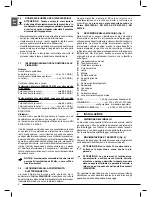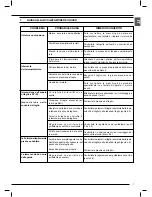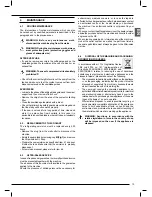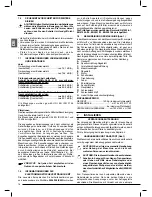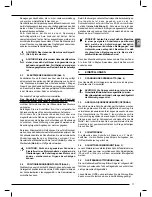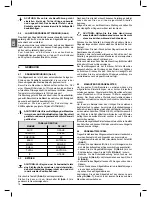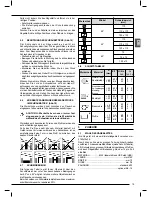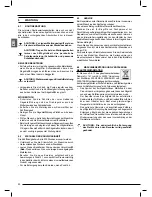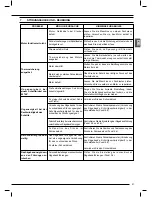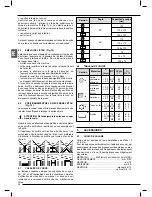
EN
11
3.6
BEARINGS BLADE GUIDE (Fig. 6)
The blade guides
A
on the outside of the sawing machine are
eccentric and adjustable so as to semplify blade replacement
and to keep it guided as its best.
They must always touch the blade slightly, so that they rotate
when the blade passes, but must not be completely locked.
In order to approach or remove the eccentric blade guides,
gently turn the head of the screws
B
using a 10 mm. wrench
key.
4 USE
4.1
BLADE COOLING (Fig. 8)
Your sawing machine is equipped with an automatic blade
cooling system controlled by a motor pump
A
positioned
inside the tank.
Before operating the machine, prepare
12 litres
of a 10% oil-
water emulsion by pouring directly the necessary oil into the
water with a temperature not lower than 10 degrees.
Agitate the mixture thoroughly and pour it in the pump tank
B
.
Do not operate the machine without coolant to avoid damage
to the blade.
Use the oil specifi ed for the preparation of the coolants (see
OIL TABLE)
WARNING: Always check that the lubrication jet is
aimed towards the blade and that its cock is not
opened too much before you put the machine in
operation.
WARNING: Keep your left hand away from the
cutting area and on no account try to reach it when
cutting is in process.
Using the index fi nger of your right hand, press the run button
and gradually lower the machine body until it comes lightly into
contact with the part to be cut.
Now begin to apply gradual pressure on the part and complete
the cut.
Always release button between one cutting operation and
another, while you are positioning the part. do not try to block
it or alter its functional characteristics in any way.
If the machine suddenly stops after numerous consecutive
cuts, do not be alarmed.
The heat protector device of the motor has been activated,
breaking the power supply when the temperature of the coils
reaches the threshold limit defi ned by the insulation class, to
prevent damage to the motor.
In this case, release the button and wait for automatic reset
which usually takes place after a few minutes.
4.3
RUNNING IN THE BLADE
To obtain the best performance, the bi-metal blades fi tted on
your sawing machine must be run in for a short period.
For this reason the fi rst two or three cuts should be done where
possible on a solid piece D.70-80 mm, using a very slight
pressure on the blade, and gradually increasing pressure in
subsequent cuts.
To gauge the correct pressure in normal operating conditions
defi ned by this manual (see cutting table), consider for example
that the fi rst cut on solid steel (eg. C40) D.80 mm should be
done in about 5 minutes.
After running-in, the same piece may easily be cut in about 2
minutes. If the running-in process is done correctly, the fi nish
and precision of the cut will be of better quality and the blade
will last longer.
4.4
REPLACING THE BLADE
When you perform this operation, always wear protective
gloves to avoid contact with the teeth of the blade.
• make sure that the main switch
B (Fig. 3)
is on position 0;
• turn the handwheel
B (Fig. 4)
counterclockwise until the
tensioning device indicator turns off;
• loosen handles
D
(Fig. 4)
to move the sawblade guides
E
(Fig. 4)
as far as they go;
• loosen screws
A (Fig. 9)
and remove the safety guard by
lifting it from its seat
B
(Fig. 9)
;
• fi t the new blade fi rst between the guides, then onto the
wheels;
• tighten the blade again.
AGIP
OXALIS
CASTROL
SUPER
CHEVRON
EP
ESSO
KUTWELL
MOBIL
SOLVAC
SHELL
DROMUS
TOTAL
LACTUGA
IP
UTENS
OIL
TABLE
BRAND
OIL
TYPE
4.2 WORKING
WARNING: Before any cutting operation, check
that all safety guards are sound and correctly
positioned.
Press button
C
(Fig. 3)
of main switch
B (Fig. 3)
.
Select the desired speed by means of the speed variator
provided.
Once you have completed all the procedures and operations
described so far, you may start the working processes.
To perform the cut, move to the front of the machine and grip
the handgrip with your right hand.






